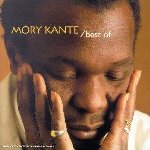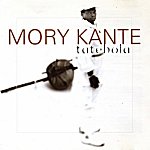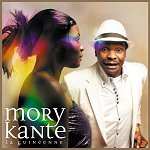|
|
  Mory Kanté (1950~2020), le « griot électrique » guinééen à l'immense renommée fut révélé au grand public par son tube planétaire Yéké Yéké - chant populaire guinéen plutôt lent à l'origine mais boosté par les boites à rythmes des années 80 - sur l'album Akwaba beach, « tube qui sera vendu à 2 millions d'exemplaires et même traduit en hébreu et en chinois. » Mory Kanté (1950~2020), le « griot électrique » guinééen à l'immense renommée fut révélé au grand public par son tube planétaire Yéké Yéké - chant populaire guinéen plutôt lent à l'origine mais boosté par les boites à rythmes des années 80 - sur l'album Akwaba beach, « tube qui sera vendu à 2 millions d'exemplaires et même traduit en hébreu et en chinois. »
© Nago Seck & Sylvie Clerfeuille, Les musiciens du beat africain [ bibliographie]
  Le grand public connut surtout Mory Kanté comme chanteur et korafoláUn korafolà est un joueur de kora en Mandinka (qui fait parler la kora) - korafolàlù, au pluriel. ; certes, il fut initié à la kora durant son adolescence, après son arrivée au Mali, par le grand Batourou Sékou Kouyaté Le grand public connut surtout Mory Kanté comme chanteur et korafoláUn korafolà est un joueur de kora en Mandinka (qui fait parler la kora) - korafolàlù, au pluriel. ; certes, il fut initié à la kora durant son adolescence, après son arrivée au Mali, par le grand Batourou Sékou Kouyaté
Batrou Sekou Kouyaté très grand korafolá du Mali... Lire la suite. ; là, une complicité naquit et Mory devint un partenaire privilégié du légendaire korafoláUn korafolà est un joueur de kora en Mandinka (qui fait parler la kora) - korafolàlù, au pluriel. ; cependant, l'on sait moins que le premier instrument qu'il pratiqua fut le balafon - instrument privilégié de sa famille : ainsi, « l'enseignement traditionnel du petit Mory commence auprès de son père, El Hadj Djéli Fodé Kanté, alors chef des griots de Kissidougou, qui s'éteindra à l'âge de 109 ans. Parmi les derniers de ses 38 enfants, Mory suit l'école française et apprend à jouer du balafon, l'instrument emblématique des Kanté. »
 On retrouve d'ailleurs Mory Kanté au balafon dans une interprétation magistrale de Mali SadioMali Sadio est une chanson, tirée d'un conte populaire du début du XXe siècle.... Lire la suite. sur la compilation : Royaume du Mande. Cette formation percussive initiale éclaire, à mon sens, sa prédilection pour les rythmes appuyés et son intérêt pour les instruments traditionnels à percussion comme en témoigne la richesse instrumentale de son album : Sabou. On retrouve d'ailleurs Mory Kanté au balafon dans une interprétation magistrale de Mali SadioMali Sadio est une chanson, tirée d'un conte populaire du début du XXe siècle.... Lire la suite. sur la compilation : Royaume du Mande. Cette formation percussive initiale éclaire, à mon sens, sa prédilection pour les rythmes appuyés et son intérêt pour les instruments traditionnels à percussion comme en témoigne la richesse instrumentale de son album : Sabou.
 Si Mory Kanté n'hésite pas à revisiter les classiques de la musique traditionnelle comme Alla La KeCet air est le plus célèbre de l'ancienne tradition mandingue... Lire la suite. - sous le titre Mali-Ba (album Tatebola) ou NanfoulenNanfoulen, chant d'amour, d'origine populaire et guinéenne, est de création assez récente... Lire la suite., il est plus attiré par les mélodies du folkore populaire qu'il modernise avec réussite. Si Mory Kanté n'hésite pas à revisiter les classiques de la musique traditionnelle comme Alla La KeCet air est le plus célèbre de l'ancienne tradition mandingue... Lire la suite. - sous le titre Mali-Ba (album Tatebola) ou NanfoulenNanfoulen, chant d'amour, d'origine populaire et guinéenne, est de création assez récente... Lire la suite., il est plus attiré par les mélodies du folkore populaire qu'il modernise avec réussite.
|
| À Paris |
 |
|
1. Ye Ke Ye Ke
2. Gnaba Lemba
3. Wari Massilani
4. Ça va là-bas
5. M'Balou
6. Soumba |
|
|
| 10 cola nuts |
 |
|
|
|
| Akwaba Beach |
 |
|
|
| Touma |
 |
|
|
| Tatebola |
 |
|
|
| The Best Of Mory Kante |
 |
|
|
| Tamala |
 |
|
|
| Sabou |
 |
|
1. Nafiya
2. Djou
3. Mama
4. Diananko
5. Sabou
6. Kenkan
7. Moko
8. Loniya
9. Desole
10. Biriya
|
|
| La Guinéenne |
 |
|
1. Yarabini
2. La Guinéenne
3. Tedekou
4. Oh Oh Oh
5. Saratan
6. Mbalia
7. Bedoke
8. Sikaa
9. Malibala
10. Nodiche
|
|
|